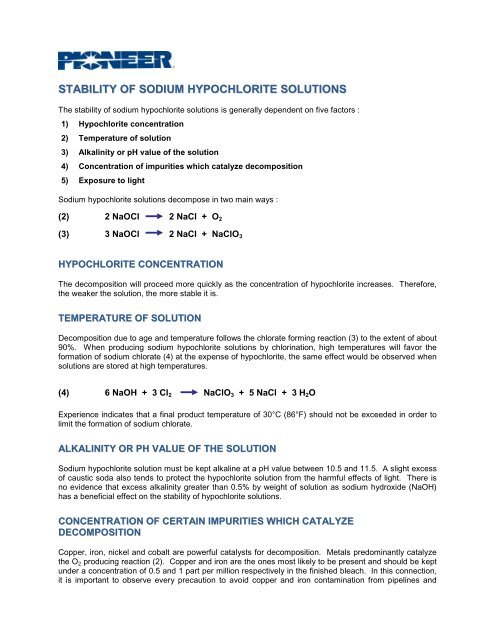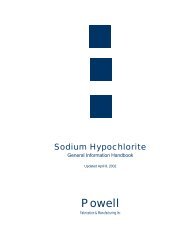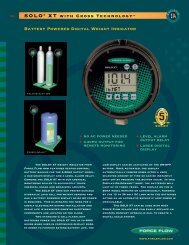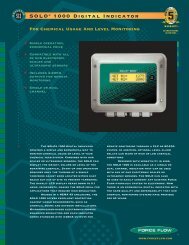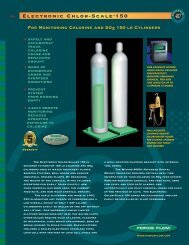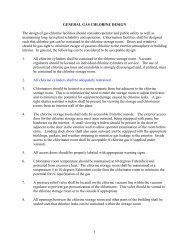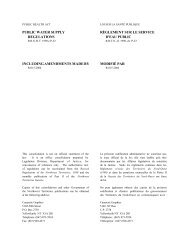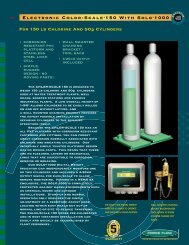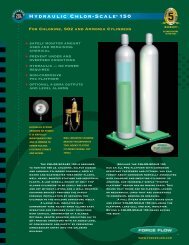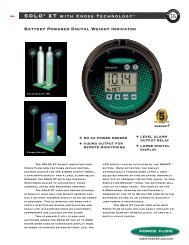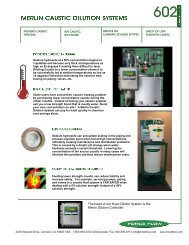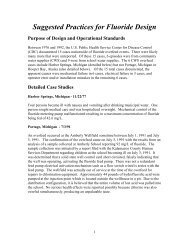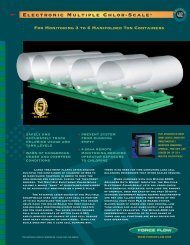STABILITY OF SODIUM HYPOCHLORITE SOLUTIONS - Force Flow
STABILITY OF SODIUM HYPOCHLORITE SOLUTIONS - Force Flow
STABILITY OF SODIUM HYPOCHLORITE SOLUTIONS - Force Flow
You also want an ePaper? Increase the reach of your titles
YUMPU automatically turns print PDFs into web optimized ePapers that Google loves.
<strong>STABILITY</strong> <strong>OF</strong> <strong>SODIUM</strong> <strong>HYPOCHLORITE</strong> <strong>SOLUTIONS</strong><br />
The stability of sodium hypochlorite solutions is generally dependent on five factors :<br />
1) Hypochlorite concentration<br />
2) Temperature of solution<br />
3) Alkalinity or pH value of the solution<br />
4) Concentration of impurities which catalyze decomposition<br />
5) Exposure to light<br />
Sodium hypochlorite solutions decompose in two main ways :<br />
(2) 2 NaOCl 2 NaCl + O 2<br />
(3) 3 NaOCl 2 NaCl + NaClO 3<br />
<strong>HYPOCHLORITE</strong> CONCENTRATION<br />
The decomposition will proceed more quickly as the concentration of hypochlorite increases. Therefore,<br />
the weaker the solution, the more stable it is.<br />
TEMPERATURE <strong>OF</strong> SOLUTION<br />
Decomposition due to age and temperature follows the chlorate forming reaction (3) to the extent of about<br />
90%. When producing sodium hypochlorite solutions by chlorination, high temperatures will favor the<br />
formation of sodium chlorate (4) at the expense of hypochlorite, the same effect would be observed when<br />
solutions are stored at high temperatures.<br />
(4) 6 NaOH + 3 Cl 2 NaClO 3 + 5 NaCl + 3 H 2 O<br />
Experience indicates that a final product temperature of 30°C (86°F) should not be exceeded in order to<br />
limit the formation of sodium chlorate.<br />
ALKALINITY OR PH VALUE <strong>OF</strong> THE SOLUTION<br />
Sodium hypochlorite solution must be kept alkaline at a pH value between 10.5 and 11.5. A slight excess<br />
of caustic soda also tends to protect the hypochlorite solution from the harmful effects of light. There is<br />
no evidence that excess alkalinity greater than 0.5% by weight of solution as sodium hydroxide (NaOH)<br />
has a beneficial effect on the stability of hypochlorite solutions.<br />
CONCENTRATION <strong>OF</strong> CERTAIN IMPURITIES WHICH CATALYZE<br />
DECOMPOSITION<br />
Copper, iron, nickel and cobalt are powerful catalysts for decomposition. Metals predominantly catalyze<br />
the O 2 producing reaction (2). Copper and iron are the ones most likely to be present and should be kept<br />
under a concentration of 0.5 and 1 part per million respectively in the finished bleach. In this connection,<br />
it is important to observe every precaution to avoid copper and iron contamination from pipelines and
valves, which may be used in handling the chlorine. All lines and valves must be kept internally free of<br />
moisture to prevent rapid corrosion by the chlorine.<br />
EXPOSURE TO LIGHT<br />
Light speeds up the decomposition of sodium hypochlorite solutions. Modern packaging methods and<br />
use of polyethylene bottles have practically eliminated the influence of light on bleach stability. The use<br />
of green or amber glass bottles will also materially reduce decomposition caused by light.<br />
In summary, the most stable solutions are those of low hypochlorite concentration, with a pH of 10 or<br />
higher, low copper, iron and nickel content, and stored in the dark at low temperatures.


